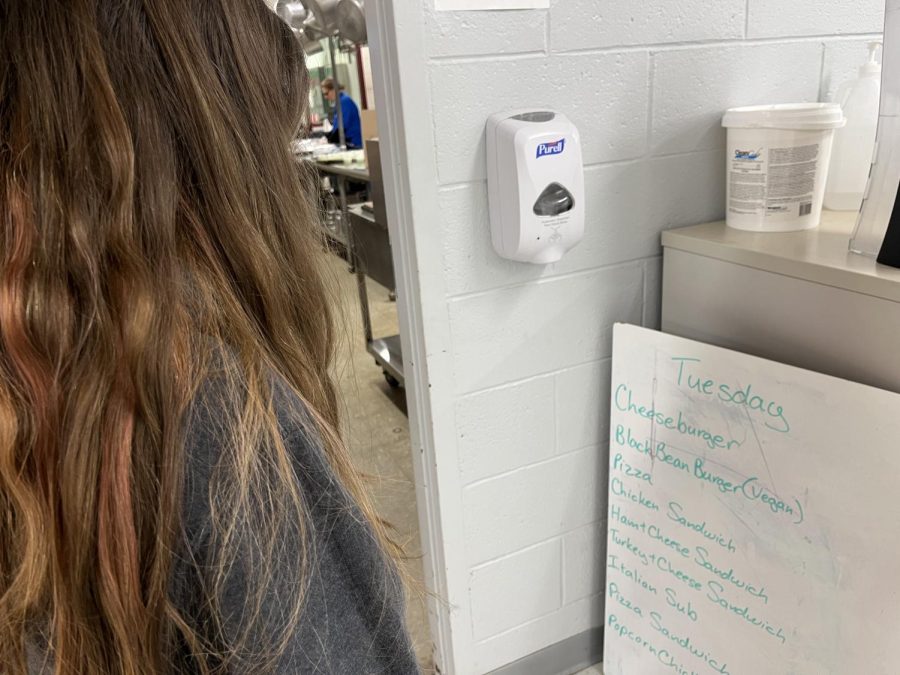Eating disorders: a silent epidemic
LUNCH DECISIONS: A girl decides what she wants to eat for lunch.
Apr 6, 2022
Over the past three years, all of our focus has been on the Covid-19 pandemic. Though it is important, we’ve forgotten about other issues in the world. Since the pandemic hit, eating disorders have increased 25%; there have also been uprisings in depression, anxiety, drug and alcohol use, as well as insomnia.
WMS seventh grader, Destiny Colon, said she didn’t know about the increase in eating disorders and other mental health issues, though she could think of reasons why, “You have all this time on your hands. You have all that access to food, and ever since the pandemic I’ve realized social image has increased.”
Colon continued to explain how social media contributes to the problem, “How people will set standards for how you should look, and because of the pandemic people have been, I guess more focused on social media. Started posting a whole lot more than usual and everything. So because of that they start trying to meet those expectations of people.”
Potential reasons for the increase in eating disorders while being home are; loneliness, depression and anxiety worsening, stress, over exercising, and social media.
Colon furthered saying social media has a large impact on why eating disorders are more popular in women than men, “There’s always that social image, that women have to be small or petite, as for men you don’t expect that as much, that’s just the way about the world.”
Social media is not the only progenitor of eating disorders, schools shoulder some of the responsibility for not having enough education on the topic.
Sophia Costa, seventh grade student, and Destiny Colon agreed, saying schools only “vaguely” go over the topic. Both Costa and Colon could name two types of eating disorders, anorexia and bulimia, but couldn’t explain what they were, proving the need for more education in schools.
Colon said she only learned about them because she was “bored as a child.”
In schools, students normally only learn the most common types of eating disorders; anorexia nervosa, bulimia nervosa, and binge eating disorder. However, there are ten others that you wouldn’t know unless you researched it on your own time.
The other ten are
Muscle Dysmorphia: Found more in men, obsession with musculature and physique.
Other Specified Feeding or Eating Disorder: An eating disorder that doesn’t fit into specific categories.
“Unofficial” Eating Disorder Diagnoses: Disorders that are not included in any diagnostic manual.
Compulsive Overeating: Similar to binge eating disorder, but instead eating large amounts of food all day long.
Prader Willi Syndrome: Genetic disease, causes insatiable hunger.
Diabulimia: Someone who is diabetic and uses their insulin to try and induce weight loss.
Orthorexia Nervosa: Obsession with planning a perfect diet that starts to negatively affect your life.
Selective Eating Disorder: Selective about what they eat, sticking to two meals a day, which causes them to become sick.
Drunkorexia: Restricts food and purges, so they can “save calories” to drink alcohol.
Pregorexia: Pregnancy weight loss plan that could be too extreme that can endanger both mom and baby.
There are many ways to spread awareness and improve how schools talk about eating disorders. Colon and Costa suggested going over the topic more in health class, learning about less common types of eating disorders, and putting up bulletins around the school.
Colon also said, “You know how guidance counselors have those talks? Or like how they come around to all the rooms and have those presentations?” Guidance counselors do regular presentations on bullying and cyberbullying. They could do a presentation about body image and eating disorders. We’re all going through awkward stages in our lives, and it would be nice to feel not alone and have comfort in believing others do understand.
Mrs. Valente said she hadn’t thought of doing a presentation on eating disorders, “It’s a topic that could be addressed more. We don’t really know how many students who might have or are unaware of possibly having an eating disorder.”
Numerous mental health issues can come from school, the most frequent being Anxiety. Having to submit all your assignments on time, believing one test will make or break your future, worrying about peers, combined with everything you have going on outside of school can take a toll on your mental health.
Costa said, “I think schools have to get better at this thing where, it’s like, if you fail, you’re immediately stupid, and all your prospects are gone,” she furthered saying it’s hard with work because students have busy schedules.
Virtual school had its stressful moments too, for example when wifi would cut out, and not understanding lessons as well as you would have if you were in person. This can often trigger negative feelings associated with eating disorders, because people feel like they have no control.
“I guess it’s equal amounts. I will say that once the pandemic hit and I was put in online school, my grades definitely did drop. It was a lot harder to keep track of what I was supposed to do work wise. Now that I’m back in school it’s the same thing, well it’s a whole other new experience because we’ve been in lockdown for so long,” Colon said.Through the Covid 19 pandemic everyone has had their struggles. If you or a loved one are struggling with an eating disorder you can call the NEDA Helpline. 1-800-931-2237 https://www.nationaleatingdisorders.org/





